Introduction: A Bridge Between Traditions
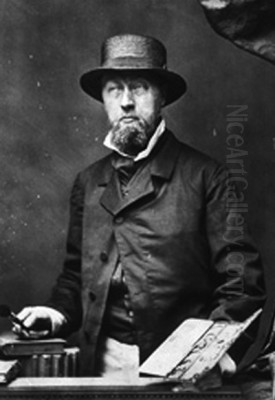
Johan Barthold Jongkind stands as a pivotal figure in nineteenth-century European art, a Dutch painter and printmaker whose work forms a crucial link between the landscape traditions of his homeland and the revolutionary emergence of Impressionism in France. Born in Lattrop, Overijssel, in the Netherlands on June 3, 1819, and passing away in La Côte-Saint-André, near Grenoble, France, on February 9, 1891, Jongkind's life and art traversed geographical and stylistic boundaries. He is widely celebrated today, primarily for his evocative landscapes and marine scenes, and recognized by art historians and artists alike, notably Claude Monet, as a foundational influence on the Impressionist movement. His unique ability to capture the fleeting effects of light and atmosphere, particularly in his watercolors and later oil paintings, marked him as an innovator whose vision anticipated the core concerns of the artists who would soon change the course of Western art.
Early Life and Artistic Formation in the Netherlands
Johan Barthold Jongkind was born into a family of reasonable means; his father, Gerrit Adrianus Jongkind, served as a tax collector and customs inspector. The family relocated to Vlaardingen and later Overschie, near Rotterdam, during his youth. Tragedy marked his early years with the deaths of his younger sister Johanna in 1826 and his older brother Laurens-Christiaan in 1829, events that likely cast a shadow over his formative experiences. Showing an early aptitude for drawing, his artistic inclinations were encouraged, leading him to pursue formal training.
Around 1836 or 1837, Jongkind began his studies at the Tekenakademie (Drawing Academy) in The Hague. Crucially, he entered the studio of Andreas Schelfhout, a leading landscape painter of the Dutch Romantic school. Schelfhout was renowned for his meticulously detailed winter scenes and seascapes, executed in a traditional style. Under Schelfhout's tutelage, Jongkind mastered the fundamentals of landscape painting, absorbing the Dutch tradition's emphasis on careful observation, detailed rendering, and the dramatic potential of the native landscape, particularly its wide skies and waterways. This grounding in Dutch realism would remain a subtle underpinning throughout his career, even as his style evolved dramatically.
The Allure of Paris: New Influences and Early Recognition
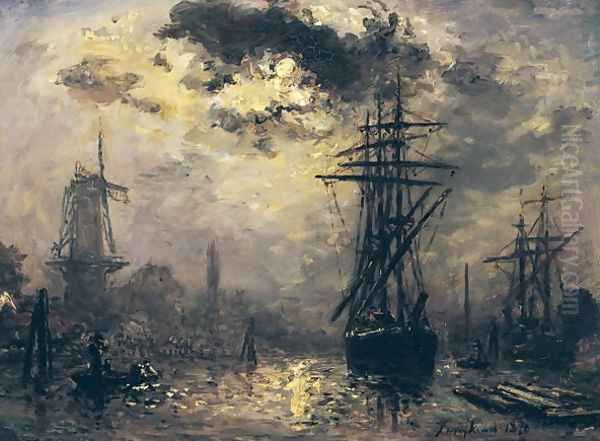
Supported by a royal grant from Willem II, Prince of Orange, Jongkind made the pivotal move to Paris in 1846. This relocation immersed him in the vibrant, competitive, and rapidly evolving art world of the French capital. He sought out further instruction, joining the ateliers of the marine and landscape painter Eugène Isabey and the Neoclassical history painter François-Édouard Picot. Isabey's looser brushwork and interest in atmospheric effects likely resonated more strongly with Jongkind's developing sensibilities than Picot's academic rigor.
Paris exposed Jongkind to a wider range of artistic currents. He encountered the work of the Barbizon School painters, such as Jean-Baptiste-Camille Corot, Charles-François Daubigny, and Théodore Rousseau, who were pioneering a more direct, naturalistic approach to landscape, often working outdoors to capture authentic light and scenery. While Jongkind rarely painted his finished oils entirely en plein air, the Barbizon emphasis on direct observation and capturing the 'mood' of nature undoubtedly influenced him. He began exhibiting at the official Paris Salon in 1848, and his early submissions garnered positive attention from perceptive critics like Charles Baudelaire and later Émile Zola, who recognized the freshness and sincerity in his work, particularly his handling of light.
Forging a Unique Vision: Light, Water, and Spontaneity
Jongkind's artistic style began to crystallize during his years shuttling between France and the Netherlands. He developed a distinctive approach characterized by a remarkable sensitivity to light and atmosphere, combined with an increasingly free and energetic brushstroke. He became particularly adept at depicting water – the canals of Holland, the bustling ports like Rotterdam, and the River Seine in Paris. His paintings captured the reflections, the transparency, and the movement of water with unprecedented immediacy.
A key element of his working method was his prolific use of watercolor. He would make numerous sketches outdoors, rapidly capturing the transient effects of weather, time of day, and light conditions. These watercolors, often executed with astonishing freedom and transparency, were not merely preparatory studies but vibrant works in their own right. They possess an immediacy and spontaneity that directly anticipates Impressionism. Back in his studio, Jongkind would use these sketches, along with his memory, to compose his oil paintings. While the oils retained some of the structure learned from Schelfhout, they increasingly incorporated the broken brushwork and luminous color observed in his outdoor studies.
Master of Seascapes and Moonlit Scenes
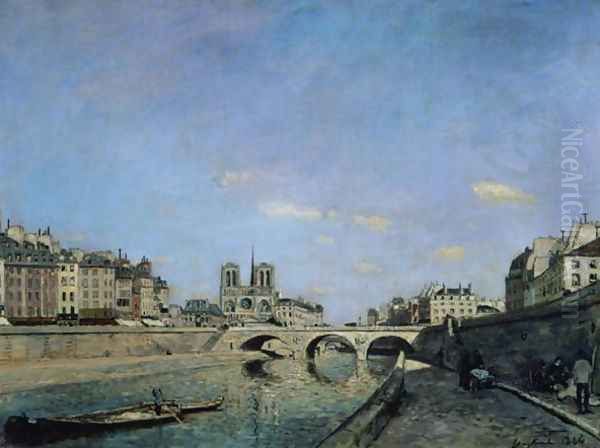
Water remained a dominant theme throughout Jongkind's oeuvre. His Dutch heritage provided him with an innate understanding of marine environments, which he explored in numerous paintings of harbors, estuaries, and coastal views, both in the Netherlands and later along the Normandy coast. Works like View of the Port of Rotterdam showcase his ability to combine topographical accuracy with a lively depiction of maritime activity and atmospheric conditions.
He was also a master of nocturnal scenes, particularly moonlit landscapes. Paintings such as Dutch Canal in Moonlight or views of Paris under the moon demonstrate his fascination with the subtle gradations of light and shadow at night. He managed to convey the cool luminescence of moonlight on water and architecture with a palette that, while often subdued, was highly effective in evoking a specific mood, often tinged with Romantic sensibility yet rendered with a proto-Impressionist concern for optical effects. This focus on specific, often unusual, light conditions set him apart from many of his contemporaries.
Jongkind and the Nascent Impressionist Movement
Jongkind's most significant contribution to art history lies in his role as a catalyst for Impressionism. Although he never exhibited with the Impressionists in their group shows (the first of which occurred in 1874, when Jongkind was already established, albeit struggling), his influence on the key figures of the movement was profound and widely acknowledged by the artists themselves.
The most crucial connection was with Claude Monet. The two artists met around 1862 in Normandy, likely in Le Havre or nearby Honfleur, where Jongkind often painted alongside Eugène Boudin. Boudin, known for his delicate beach scenes and sky studies, was already mentoring the young Monet, encouraging him to paint outdoors. However, it was Jongkind's impact that Monet later described as decisive. Monet famously stated, "From that time he was my real master. It was to him that I owed the final education of my eye." Jongkind's bold sketches, his way of structuring a landscape while capturing its fleeting light, provided Monet with a crucial model for developing his own revolutionary style.
Jongkind's influence extended to other future Impressionists. He was friendly with Camille Pissarro and Alfred Sisley, both of whom shared his dedication to landscape and his interest in capturing atmospheric nuances. His free handling of paint and his emphasis on direct observation, even if finalized in the studio, provided a vital precedent for their own explorations. Édouard Manet, another pivotal figure of the era often associated with the Impressionists, also recognized Jongkind's talent, calling him the "father of modern landscape painting."
Navigating the Art World: Salons and Sales
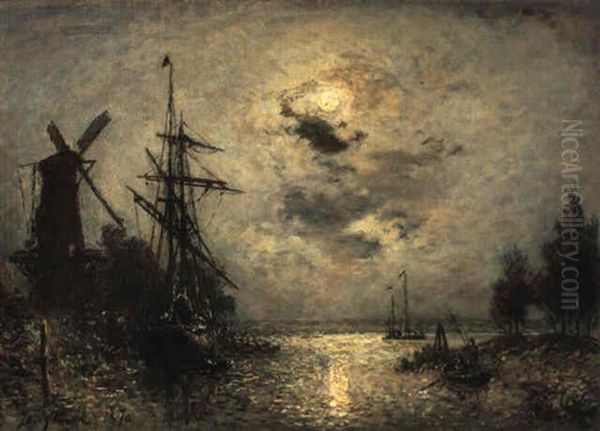
Despite the admiration of fellow artists and some critics, Jongkind's career was marked by financial instability and inconsistent recognition from the official art establishment. His style, particularly its sketch-like immediacy and departure from academic finish, often met with incomprehension or rejection from the conservative juries of the Paris Salon. He participated in the landmark 1863 Salon des Refusés, an exhibition organized to showcase works rejected by the official Salon that year. This event, featuring Manet's scandalous Le Déjeuner sur l'herbe, became a rallying point for the avant-garde. Jongkind's presence there further cemented his association with progressive artistic tendencies.
He continued to submit works to the Salon throughout his career, sometimes gaining acceptance, sometimes facing rejection. He relied on sales through dealers and the support of a few dedicated collectors. An auction organized by his friends in 1860 helped alleviate a period of severe financial distress and enabled his permanent return to France. However, consistent financial security remained elusive for much of his life.
Expertise in Etching and Watercolor
Beyond his oil paintings, Jongkind made significant contributions as a printmaker and watercolorist. He embraced etching with enthusiasm, producing numerous plates, often depicting Dutch landscapes with windmills and canals, or views of Paris. His etching style mirrored his drawing – free, linear, and expressive, capturing the essence of a scene with economy and vigor. He sometimes collaborated with other artists, including the notable printmaker Félix Bracquemond.
His mastery of watercolor was exceptional. As mentioned, these were central to his process, but they also stand as independent achievements. His technique was fluid and transparent, using washes of color and rapid brushstrokes to convey light and atmosphere with remarkable freshness. In 1878, he became a founding member of the Société des Aquarellistes Français (French Society of Watercolourists), indicating the high regard in which his work in this medium was held by his peers. These watercolors arguably represent the most 'Impressionistic' aspect of his output in their immediacy and focus on transient effects.
A Life Between Countries: Travels and Inspiration
Jongkind's life involved significant movement, particularly between his native Netherlands and his adopted home, France. He returned to Holland periodically, notably residing there between 1855 and 1860. During these periods, he revisited the landscapes of his youth, painting canals, windmills, and port scenes around Rotterdam and Dordrecht. These Dutch works often possess a specific character, reflecting the flat terrain and distinctive light of the Low Countries.
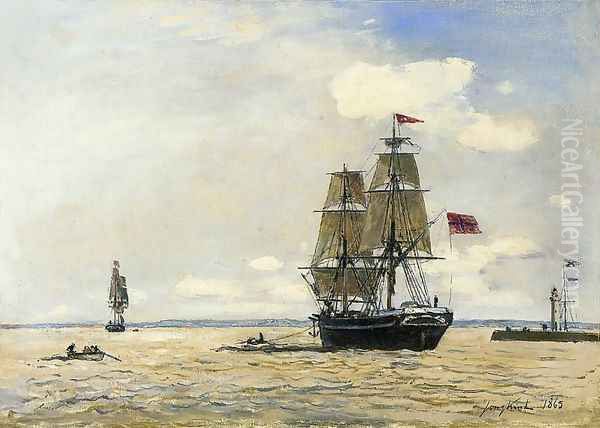
In France, Paris and its surroundings, especially the Seine, were frequent subjects. However, his travels to Normandy in the early 1860s were particularly fruitful, providing coastal subjects and facilitating his influential encounters with Boudin and Monet in places like Honfleur and Sainte-Adresse. Later in life, from the late 1870s onwards, he spent increasing time in the Dauphiné region in southeastern France, near Grenoble, where his companion Joséphine Fesser had family. The more mountainous landscapes of this region offered new motifs, though his fundamental approach to capturing light and atmosphere remained consistent.
Personal Struggles and Final Years
Jongkind's life was unfortunately plagued by personal difficulties. Alongside his financial worries, he suffered from recurring bouts of depression and paranoia, exacerbated by heavy drinking. His mental health deteriorated significantly in his later years. Friends and fellow artists, including Monet and Boudin, sometimes intervened to offer support or organize sales of his work to help him financially.
His relationship with Joséphine Fesser, a Dutch woman living in France whom he met around 1860, provided crucial stability and companionship for much of his later life. She managed his affairs and cared for him through his periods of illness. Despite these challenges, he continued to paint and draw with remarkable dedication. In his final years, his mental state worsened, leading to his admission to a psychiatric hospital in Saint-Égrève, near Grenoble. He died there in February 1891 and was buried in the nearby cemetery of La Côte-Saint-André.
Enduring Legacy and Art Historical Place
Johan Barthold Jongkind occupies a unique and vital position in the narrative of 19th-century art. While rooted in the Dutch landscape tradition of precise observation, he transcended its conventions through his innovative focus on light, his dynamic brushwork, and his embrace of the sketch aesthetic. He was not an Impressionist in the strictest sense – he rarely completed his oils entirely outdoors and maintained a degree of structure often absent in fully developed Impressionist works by Monet or Renoir. Yet, his pioneering efforts to capture the fleeting moment, the specific quality of light, and the atmosphere of a place directly paved the way for their breakthroughs.
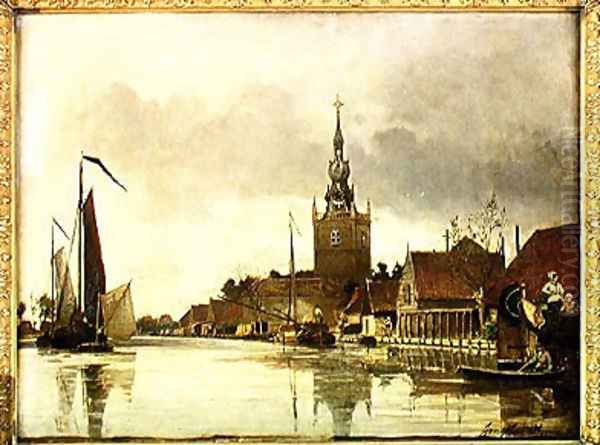
His influence, acknowledged explicitly by Monet and evident in the works of Boudin, Pissarro, and Sisley, confirms his status as a crucial precursor. Art historians recognize him as a bridge figure, linking the realism of the Barbizon school (Corot, Daubigny) and Dutch tradition (Schelfhout) with the light-filled canvases of Impressionism. Though overshadowed during his lifetime by official censure and personal struggles, and perhaps less famous than the Impressionists he inspired, Jongkind's reputation has steadily grown. Today, his works are admired for their freshness, authenticity, and technical brilliance, particularly his luminous watercolors and evocative marine paintings. He remains a testament to the power of individual vision in driving artistic change, a Dutch master who helped teach the French avant-garde how to see the light. His legacy endures in the countless landscapes that prioritize atmosphere and the transient beauty of the observed world.